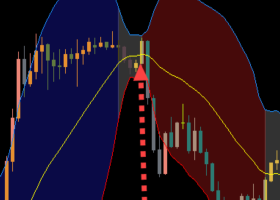Trading Strategy Using Order Blocks
1. Confirm the TrendHigher Timeframe (HTF) Analysis: Start by identifying the trend direction using a higher timeframe. This could be daily or 4-hourly charts, depending on your preference and trading style. Determine whether the trend is bullish or bearish.
2. Identify Order Blocks (OB)
- Higher Timeframe Order Block (HTF OB): Look for significant price areas where price action has shown a strong reversal or consolidation. These are your Order Blocks on the higher timeframe. These blocks are crucial because they represent areas where institutional traders placed significant orders, causing a strong reaction in price.
3. Wait for a Pullback
- Wait for Price to Pull Back: After identifying the HTF OB, wait for price to retrace or pull back towards this level. This pullback signifies a potential opportunity to enter in the direction of the overall trend identified in Step 1.
4. Entry on Smaller Timeframes
- Lower Timeframe Analysis: Once the price reaches the HTF OB and starts to show signs of stalling or reversing on the smaller timeframes (such as 1-hour or 15-minute charts), switch your focus to these lower timeframes.
5. Break of Structure Confirmation
- Identify Break of Structure: Look for a break of structure on the lower timeframe that aligns with the direction of the higher timeframe trend. A break of structure could be a higher high (for a bullish trend) or a lower low (for a bearish trend).
6. Entry Points
- Enter the Trade: There are two possible scenarios for entering the trade on the lower timeframe:
- First Entry: Enter as soon as the break of structure occurs on the lower timeframe, confirming continuation in the direction of the HTF OB.
- Second Entry (Optional): Alternatively, if you miss the first entry, wait for a new pullback on the lower timeframe to another OB. This gives you a second chance to enter the trade at a potentially better price.
7. Stop Loss and Take Profit
- Set Stop Loss: Place your stop loss below the recent swing low (for long trades) or above the recent swing high (for short trades) on the lower timeframe.
- Take Profit: Aim for a target that is at least equal to your risk, preferably aiming for the next significant support or resistance level identified on the higher timeframe.
Example Scenario:
- Trend Identification: Daily chart shows a bullish trend.
- Higher Timeframe OB: Identified a strong reversal zone on the daily chart.
- Pullback: Price pulls back to the daily OB level.
- Lower Timeframe Entry: Switch to the 1-hour chart.
- Break of Structure: Look for a higher high on the 1-hour chart.
- Entry: Enter the trade on the break of structure or wait for a pullback to a smaller timeframe OB.
Notes:
- Patience: Wait for all conditions to be met before entering a trade.
- Risk Management: Always use stop losses to protect your capital.
- Confirmation: Use additional indicators or price action patterns to confirm entries if needed.
- Recommended broker for my products: https://shorturl.at/0bZT1 🔗
🔗 Trusted Brokers
🔹 Broker with low spreads: https://shorturl.at/VFRZ7
🔹 Broker with 1:500 leverage: https://shorturl.at/0bZT1
📈 Top Prop Firms
🔹 Recommended Prop Firm (FTMO): https://ftmo.com/en/?affiliates=VWYxkgRcQcnjtGMqsooQ
🔹 US-Friendly Prop Firm (10% OFF with code DOITTRADING): https://shorturl.at/7rPXM
💻 VPS for Reliable EA Hosting
🔹 Forex VPS: https://www.forexvps.net/?aff=78368



